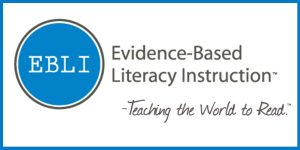EBLI is similar to traditional instruction in many ways: phonemic awareness and phonics instruction is structured, explicit, and systematic. Students immediately apply in reading and writing what was learned in the explicit instruction. Decodable stories are used for emerging readers and the students quickly move to reading authentic text. Fluency, vocabulary, comprehension, spelling, handwriting, and writing are not just addressed but are taught explicitly.
However, the many ways that EBLI is different both in teacher training and student instruction are covered in both the blog and video. These differences are what makes EBLI revolutionary and atypically effective (works well) and efficient (less time, more progress)!
GENERAL | EBLI |
Print to Speech | Speech to print |
Provides instructional activities or materials but teachers rarely know the purpose of the activity or material to improve student literacy achievement | Provides a bridge from the Science of Reading to instructional activities to teach students in the classroom: the what, why, and how |
Materials provided without teacher training or support | Teacher training and student instruction, including lessons and materials, are intertwined and teacher support is ongoing |
Teachers are encouraged to teach by delivering materials and generalizing instruction | Teachers are taught to teach to the students, provide immediate error correction, and differentiate within whole class instruction |
Instruction focused either on classroom or remediation instruction | Skills, concepts, activities, and information are consistent across Tier 1, 2, and 3 (whole class, small group, or 1:1) and for all students |
Teaches one or a few of the essential components of literacy | Systematic, explicit instruction in the foundational skills of reading, writing, and spelling including: phonemic awareness, phonics, vocabulary, fluency, comprehension, handwriting, spelling, and writing |
The components of reading, spelling, and writing are taught as isolated activities; often what was taught is not applied to reading in text or writing | Each EBLI activity explicitly teaches several components of reading, writing, and spelling. Skills and information taught explicitly are then immediately applied in reading and writing |
Sight words are taught by whole word memorization on flash cards | Sight words, and all words, are taught by sound |
Reading and spelling are taught separately | Reading and spelling are taught simultaneously |
Instruction is mostly visual | Multi-sensory instruction with an emphasis on auditory first, then visual |
Main focus is on letter names | Main focus is on sounds |
PHONICS/PHONEMIC AWARENESS | EBLI |
Blending and segmenting taught in isolation and only orally | Blending and segmenting introduced in isolation (for emerging readers only) and infused and reinforced within the EBLI activities both with and without letters present |
Advanced Phonemic Awareness skills (deletion, substitution) taught in isolation and only orally | Advanced Phonemic Awareness skills (deletion and substitution) taught as a phased activity, scaffolding from letters to all oral; advanced PA is also reinforced and applied in the context of words in many EBLI activities as well as in reading in text |
Letter names and/or sounds are taught in isolation | Sounds are taught in the context of words, including beginning reading instruction |
Blends and word families taught and memorized /bl/ /ack/ or /c/ /at/, /b/ /at/ | Sounds are taught to the smallest unit for improved reading and spelling /b/ /l/ /a/ /ck/ |
Stories and songs are taught to try to explain the inconsistencies in the English code | Instruction is streamlined, explicit, and concise, teaching only essential information |
Sound to symbol (phonics), syllable rules and exception to rules are taught to try to explain inconsistencies in the English code | Tendencies and patterns are explicitly taught and applied, avoiding the need for rules that are inconsistent and difficult for students |
Drill of rules | Hands on, multi-sensory instruction where students are simultaneously seeing, saying, hearing, touching as they are learning |
Instruction utilizes extensive worksheets and materials | Instruction utilizes whiteboards, markers, and books with few worksheets |
BALANCED LITERACY/3 CUEING SYSTEM | EBLI |
Students are encouraged to guess words, skip words, or put in what they think makes sense for unknown words | Students are taught how to read words accurately then automatically, both in isolation and in reading connected text |
Whole word memorization is taught | All words taught by sound |
Looking at the picture is encouraged to figure out the words | Reading the words on the page accurately is taught so students can read the text |
3 cueing is used to figure out words | Accurate word reading is taught for all words, leading to automatic, accurate reading |
Taught to look for little words in big words (‘phone’ has ‘one’ and ‘on’), rhyming words or word families (tomb, comb, bomb), and skipping words then going back to them | Taught to read all words left to right all the way through, that the same spelling can represent many different sounds, and that sounds can be spelled in many different ways |
Students are taught to write without concern about spelling, punctuation, grammar, capitalization, or error corrections | Students are given explicit, simple to complex writing instruction and taught how to write accurately, with correct conventions; spelling and convention errors are corrected |
Focus is on comprehension and assumes students will pick up the code mostly on their own | The English Alphabetic code is taught explicitly then applied to reading and writing, with comprehension always being the end goal |
Students teach and attempt to correct each other’s reading and writing | Components of correct reading and writing are taught and modeled; students are given support and continuous error correction to improve their reading and writing |
For emerging readers, code instruction is largely skipped and pattern books are used to encourage reading by memorizing and looking at the pictures | For emerging readers, the code that is taught immediately is reinforced by reading decodable text that uses the code that has been taught |
Reading and writing independently and extensively is how students are expected to learn to read and write | Students are taught how to read, write and spell accurately, with the quantity of writing increasing as they learn more |
Students are encouraged to read leveled books | Students are encouraged to read decodable books and move to books about what they are interested in; they are given teacher support and error corrections as needed |
Inventive spelling is taught and encouraged in writing | Students are taught how to spell correctly and spelling mistakes are corrected by the teacher and applied by the student |
STUDENT GAINS
TRADITIONAL INSTRUCTION | EBLI |
The goal is for students to make one grade level gain in one year of instruction | Students often make many grade level gains in a matter of hours of instruction |
Students who struggle typically remain stuck at a 3rd grade level in reading | Learners of all ages and ability levels improve their reading ability |
The goal is for the student to reach grade level in reading | The goal is for learners to reach their highest reading potential, often above grade level |
TEACHER TRAINING
TRADITIONAL INSTRUCTION | EBLI |
Teachers given materials and instruction manuals that tell them what to do but often lack guidance and support about how to do it with students | Year-long online teacher training and student instruction on a platform that includes example classroom instruction in schools as well as student instruction videos that teachers will play as they facilitate the instruction – gradual release of teacher learning |
Scattered: many conflicting tools in your toolbox | Systematic: All-in-one tool used across all instruction |
Some students are not able to learn to read | If a student can talk, they can learn to read |
Programs used that deliver materials that are unique to the program | System of strategies and activities that are easily infused into all reading, writing, and spelling instruction with any content or curriculum |
Provides repetition through worksheets and drill | Provides repetition through explicit instruction then reinforcement in authentic reading and writing |
PD consists mostly of delivery of information and materials | Teacher training/ PD is hands on and interactive |
There is little or no support for teachers after the PD is finished | Teachers receive continuous follow-up support through their online teacher training and student instruction platform as well as live online coaching monthly and private social media EBLI pages |
The focus is on delivery of prefabricated materials | The focus is on teaching and supporting the teacher |
What works for some students won’t work for others | All students, from valedictorians to cognitively impaired students, are taught the same skills, concepts, and information to advance their literacy abilities; repetition and error correction varies to strengthen students’ weaknesses but the activity instruction is the same |
If students don’t progress, they are labeled and/or expectations are decreased | If students don’t progress, instruction is refined and they are given small group or individualized instruction, repetition, and focused error corrections |
MATERIALS
TRADITIONAL INSTRUCTION | EBLI |
There are lots of materials to purchase | Very few materials – a whiteboard, marker, eraser, and books – are needed to teach EBLI to students |





